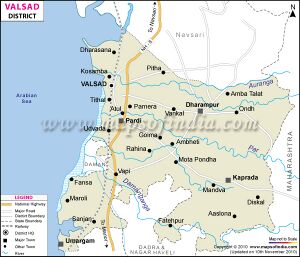Udvada
| Author:Laxman Burdak, IFS (R) |

Udvada (उदवाड़ा) is a town in Valsad district of Gujarat. It is renowned for its Zoroastrian Atash Behram fire temple. This place of fire worship is the oldest still-functioning example of its kind, and has established Udvada as a pilgrimage center for Zoroastrians the world over.
Variants
Location
Udvada is a coastal town 200 km north of Mumbai, around 8 km off the national highway, NH8. Trains ply from Mumbai to Udvada. Udvada means the 'grazing ground of camels', which it was before it became a fishing village. Its coordinates: 20°29′15″N 72°52′15″E
History
The importance of Udvada in Parsi (Indian Zoroastrian) history and religion centres around the Atash Behram (from Middle Persian Atash Warharan for "Victorious Fire", the highest grade of ritual fire of the Zoroastrians) housed in the fire temple there.
The Udvada Atash Behram is the most sacred of the Zoroastrian fire temples in India and the oldest continuously burning fire-temple fire in the world. The Udvada Atash Behram is one of nine Atash Behrams worldwide, eight of which are in western India (four in Mumbai, two in Surat, one in Navsari, and the one in Udvada), and one of which is in Yazd, in central Iran.
Following the Muslim conquest of most of Greater Iran in the 7th century, Zoroastrians gradually became a marginalized community, and by about the 10th century, the formerly Zoroastrian-held territories had become largely Islamic. One group of Zoroastrians fled from Greater Khorasan to the west coast of India in order to preserve their religious customs and beliefs. Upon landing, the refugees founded the settlement of Sanjan, which lies about 30 km south of Udvada.
According to the same legend, on their journey the Zoroastrians had carried ash from a sacred fire (according to a latter-day embellishment of the story, they had carried a fire itself), which a priest is said to have then used for the bed of the Sanjan fire when it was consecrated. A related legend recounts that this fire was consecrated as Atash Bahram fires traditionally are, that is, out of 16 fires, including that of a funeral pyre, a shepherd's hearth, a goldsmith's hearth, a potter's kiln and from a fire caused by lightning.[1]
Some centuries after their arrival (probably in the late 14th century), Sanjan was attacked by troops of the Delhi Sultanate (possibly those of Muhammad bin Tughluq)[2] and the Parsis fled again, into caves in the nearby Barhot hills, 14 km south of Sanjan. The sacred fire went with them. Several years later it was installed in Navsari. In the 18th century, a decision was made to return the flame to Sanjan, but along the way, the priests preferred to remain in Udvada, where the fire temple was consecrated in 1742. [3]
The first recorded use of the name in reference to the fire there appears in a 1905 work by Jivanji Jamshedji Modi, who made several allusions to the "Iranshah Fire" within the space of two pages. In 1920, when Shahpurshah Hodivala published his English language translation of the Qissa-i Sanjan, he assumed that this was the original name of the fire. It had been so called because it was consecrated to be the earthly representative of Yazdegerd III, the last Zoroastrian king of Iran, this explanation is accepted by almost all devout Parsis, and even the few skeptics among them tend to refer to the fire as the Iranshah.
In 1998, Sarosh Bana, executive editor with Business India, approached the then Gujarat government to declare Udvada village a ‘Heritage Precinct’. Bana organised a pictorial and architectural assessment of the village and set up a pilgrimage boarding facility and a museum showcasing the history of the Parsis and Udvada. The museum is now closed to the public.[4]
उदवाड़ा
विजयेन्द्र कुमार माथुर[5] ने लेख किया है ... उदवाड़ा (AS, p.96) गुजरात राज्य में वलसाड जिले में स्थित है. यह मुम्बई नगर से 111 मील दूर एक छोटी-सी बस्ती है। कहा जाता है कि अरबों द्वारा ईरान पर आक्रमण के समय (7-8वीं शती ई.) जो अनेक पारसी ईरान छोड़कर भारत आ गए थे उन्होंने सर्वप्रथम इसी स्थान पर अपनी बस्ती बसाई थी और अपने साथ लाई हुई अग्नि की उन्होंने यहीं स्थापना की थी। पारसियों का प्राचीन अग्नि मंदिर भी उदवाड़ा में ही है।
External links
References
- ↑ Desai, Jenny. "Udvada".
- ↑ Balaram, Gunvanti (2003-04-13). "Sanjan shards help piece together Parsi history". Times of India.
- ↑ Boyce, Mary & Kotwal, Firoze. "Irānshāh". Encyclopedia Iranica
- ↑ Desai, Jenny. "Udvada".
- ↑ Aitihasik Sthanavali by Vijayendra Kumar Mathur, p.96

